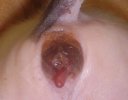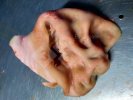Vices
Vices in weaned and growing pigs can be significant on some farms, causing economic losses and increasing animal welfare concerns.
Alternative names: abnormal behaviour, tail biting, ear biting, flank biting, navel sucking
Information
Vices can be caused by many reasons. Inadequate environments and inadequate management can cause aggression in pigs. Pigs that are biting the tails or ears of other pigs seem unhappy. The aggressive pig must be separated and brought out of the pen.
In the case of sows, vices are limited to vulva biting, especially during the last 3-4 weeks of gestation. There may be significant incidence with untethered, group-housed sows under poor management. In these cases, up to 80% of sows could have their vulva bitten. Very injured vulvas leave scarring when they heal that can cause strictures or narrowing and difficulties during farrowing.
Sows
- Vulva biting
Nursing piglets
- Prepuce sucking
Nursery
- Penis / navel sucking.
- Prepuce sucking.
- Ear sucking.
- Tail biting.
Fattening stage
- Tail biting.
- Necrosis of ears.
- Feet biting.
- Flank biting.
Symptoms
Sows
- Vulva injuries are frequent.
- Evidence of blood on the skin and nose of sows indicates the possibility of this condition.
- Severe hemorrhage leaving some animals dead.
Nursing piglets
- Not seen
Nursery and fattening
- Skin trauma and infection.
- Lameness.
- Mortality.
Causes / Contributing Factors
Management factors:
- A change in diet.
- Very humid environment.
- Too long of tails.
- Aggressive breeds.
- Air drafts.
- Lack of bedding.
- Temperature fluctuations.
- Trauma.
- High air speed.
- Uncomfortable conditions.
- High stocking density.
- Unhappy pigs.
- Lack of feeder space.
- Lack of water.
- Ammonia levels> 20 ppm.
- Pigs too small for the environment.
- Poor pen design.
- Poorly located feeders.
Nutritional factors:
- Too little salt in the diet.
- Inadequate nutrition.
- Changes in diet.
- Low feed availability.
Diagnosis
- Based on observations and skin lesions.
Control/Prevention
- Separate the affected animals.
- Separate the aggressive animals causing problems.
- Identify the main cause. This is very difficult and requires time and careful observation of pig behavior.
Atlas of pathology
See images in the Altlas related to Vices

















